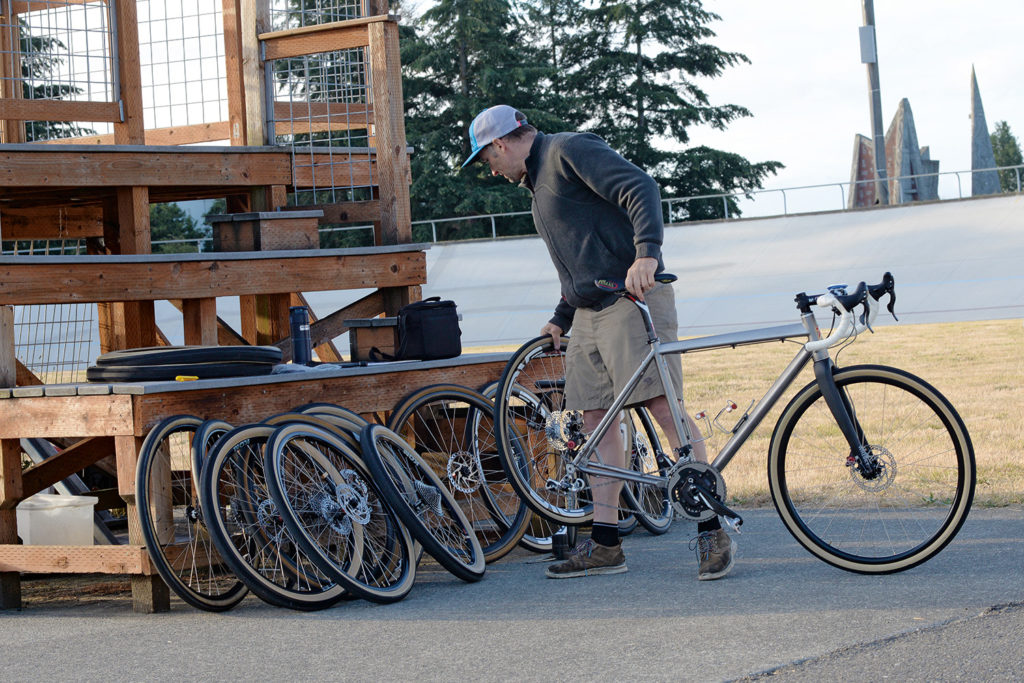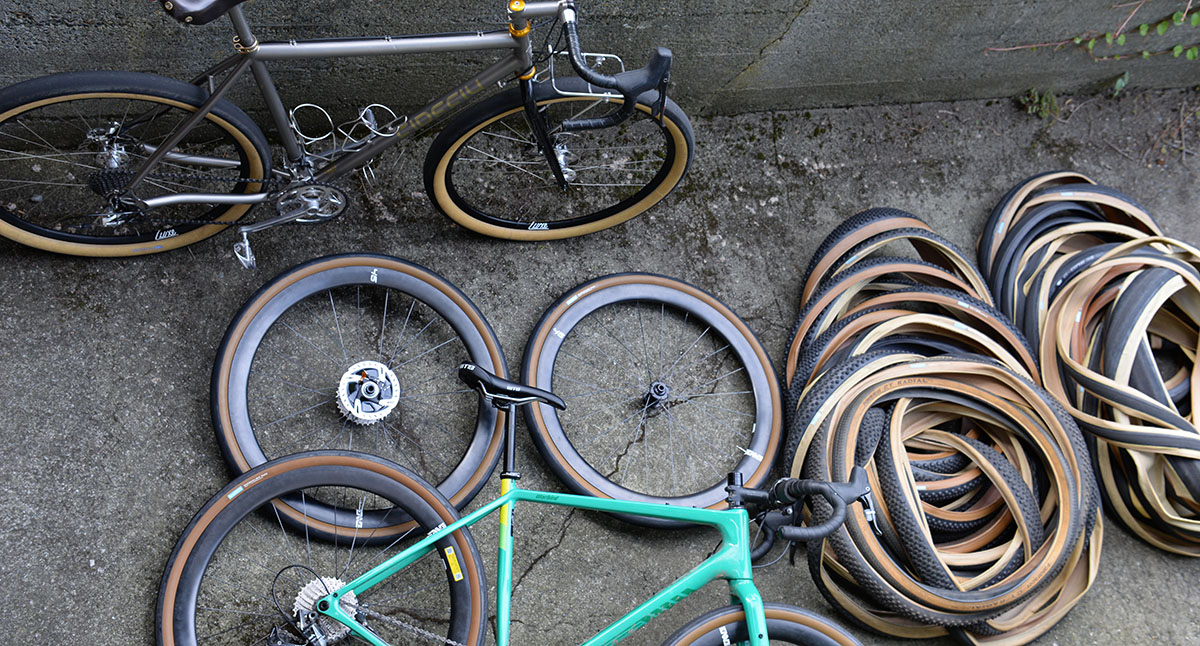What makes Rene Herse tires special?
Some cyclists find it hard to believe that a small company from Seattle can make some of the best tires in the world. Surely the big names must have much greater resources. How can a couple of scientists compete with an army of technicians in white lab coats who have multi-million dollar test rigs at their disposal?
The truth is that engineering resources in the bike industry are much smaller than many imagine. One of the fun parts of my job is to visit companies that make tires and components. Whether its our suppliers or our ‘competitors’ with whom we work on standards for tubeless tires, I’m often surprised how small most R&D departments are. Rarely are there more than a handful of people working on the engineering side, even at the big brands.

And it’s not like those engineers actually spend most of their time developing new products. What keeps them busy is mostly production engineering—figuring out why one tire mold is leaking rubber and why another tire often comes out with weird lines on the flanks—that sort of stuff. In fact, our discussions with the engineers at our suppliers are a lot about those issues. Things like where to put vent holes so that the tread patterns come out right when the tire is vulcanized.
With the responsibility of keeping a factory running, there’s very little time for ground-breaking research into what makes tires fast. That’s why the big tire makers believed for many years that narrow tires and high pressures rolled faster—until a small crew from Seattle showed that this wasn’t the case…
There’s also a misconception about proprietary materials. In reality, there aren’t many secret ingredients. Rubber compounds used in tire treads are supplied by big chemical companies and available to everybody. When long-chain polymer rubber compounds came to the market a few years ago and promised better performance, some companies branded them with fanciful names, which are easy to trademark. (If this was proprietary, you’d patent the technology, not trademark the name.)
With tires (and most other components), the secret is not in the materials, but what to do with them.

Our relationship with our suppliers is a bit like that between chefs and farmers. Above is a farm in Japan that grows some of the world’s best wasabi (Japanese horseradish).
Anybody can go to a market or a farm and buy ingredients. Good chefs know how to choose the best ingredients. The best chefs also know how to combine those ingredients and prepare them to bring out the flavors in ways that make their dishes stand out. The farmers have the ingredients, but they aren’t chefs. And the chefs aren’t necessarily good at farming. To get the best meal, you need the best chefs working with the best farmers. And the best chefs usually cook for small, independent restaurants. (Chain restaurants do have big labs working on their recipes, but few people would claim that their food is superior.)

At Rene Herse Cycles, we take the ingredients from a variety of suppliers and test them under real-road conditions. Our testing consists of two parts. We start with carefully controlled tests to figure out which tires roll fastest. Running these tests on real roads, with a rider, showed us what lab tests were missing: the suspension losses caused by vibrations of bike and rider. That real-road research started the revolution that has swept across the bike world. Today even professional racers ride on wide tires at relatively low pressures.

Just as important are our field tests. When riders like Ted King (above, in the lead), Lael Wilcox, Lauren de Crescenzo, Sofiane Sehili, Brennan Wertz and others win the toughest races on Rene Herse tires, we see this not so much as a marketing opportunity, but as an important part of our R&D.
Our R&D combines data on rolling resistance (on real roads, not in the lab) with real-world feedback on durability and all-round performance on the world’s hardest race courses. Unbound XL, Mid South, Gravel Worlds, SBT GRVL, Rad Dirt, Tour Divide, Silk Road Mountain Race, Rhino Run, Rift Iceland—most of the big races have been won on Rene Herse tires.

We’re also racing ourselves to experience the rigors of the world’s toughest courses directly and completely unfiltered. That really helps with designing tires for these conditions. Of course, not all of us at Rene Herse Cycles are racers: The unique perspectives of riders who don’t care about speed are also well-represented in our team.
As a small, nimble company, we can get data quickly. Feedback from racers goes directly to our R&D team, not to some marketing person who may forward it to the engineers—or not. We ask our racers to return their tires (unheard of in the industry, for some reason), so we can examine how they’ve performed and where they might be improved.

We don’t have deadlines for introducing new products (and we don’t go home at 5 p.m.) We can get another set of prototypes made, with slightly different ingredients, test those quickly, and repeat this process until everything is just perfect. And since we ride and race those tires ourselves, ‘good enough’ isn’t enough for us. We know what we want, and we won’t rest until we’ve figured out how to achieve it.
The engineers from our suppliers are great at turning our vision into actual tires. They have expertise in how to design a tire mold, where to put vent holes, how to make sure our tread pattern really comes out the way we want, etc. Production engineering is their specialty. Sometimes our requests run into production difficulties, and then we brainstorm together with our suppliers how to solve them.
The recipes of what goes into our tires are proprietary—our suppliers aren’t allowed to share them with other customers. In fact, we have the exclusive rights to most of our designs. For example, no other customer can get tires with the same Extralight, Endurance and Endurance Plus casings that make our tires so special. Otherwise, somebody could just benefit from all our R&D by ordering “the same as Rene Herse tires,” slap on their logo, and profit from our hard work. There are copies of Rene Herse tires out there, but they are made differently and perform differently.
As a small company, we have another advantage: low overhead. An engineer from a big tire maker once looked at the Rene Herse tires on a friend’s bike and said wistfully: “We’d love to make tires like that. But with our cost structure, they’d be way too expensive.” Being small means we can use the best and most expensive ingredients and still offer our tires at affordable prices.

We are the first to admit: A small company isn’t going to develop new rubber compounds or other chemical breakthroughs. But neither are big tire companies—those ingredients are widely available. Big companies are good at marketing—creating fanciful names for standard rubber compounds, sponsoring pro teams to race their products in the Tour de France, designing beautiful displays for bike shops and trade shows…
As a small company, our strength lies in ideas that are outside the mainstream—ultra-wide slicks and noise-cancelling knobbies are two examples—and real-world R&D. We don’t mind the hard work it takes to find out which tires roll fastest on real roads, with a rider on board, whereas most companies still test on steel drums. Direct feedback from our racers helps us make our tires more reliable on real-world courses, whereas most companies still test durability in the lab by pushing on the tire with a needle and measuring the force it takes to puncture it. As riders first and foremost, we also know what matters in the real world, and we focus our resources where they make the greatest difference.
The result are tires that we believe are unequalled in their performance, comfort, ride feel and durability. When those who ride and race on Rene Herse tires agree, then all the hard work becomes worthwhile.
Further Reading:



